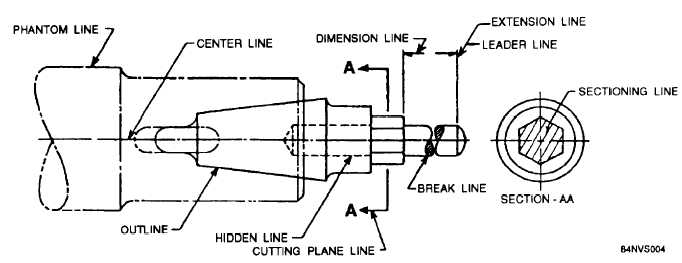Figure 1-73.–Use of standard lines
location, shape, size, and relationships of the parts of
the subassembly or unit. Detail prints show a single
part with its dimensions and all the information
needed to make a new part as a replacement.
Assembly and subassembly prints may be used to
learn operation and maintenance of machines, systems,
and equipment.
MICROFILM/APERTURE CARDS
Many prints and drawings are procured in the
form of 16- and 35-mm microfilm. Microfilm prints
and drawings are available mounted on aperture
(viewer) cards, as well as in roll form. A reader or
some type of projector is required to enlarge the
microfilm for reading. Activities are provided with a
microfilm reader-printer, which as its name implies,
enlarges the microfilm for reading and also has the
capability of printing a working copy in a matter of a
few seconds.
Microfilm greatly reduces the size of otherwise
bulky files, which is very important aboard ship.
SCHEMATIC DIAGRAMS
Schematic diagrams show by means of single lines
and symbols how the parts of a system are connected
for the operation of the system.
Piping
Piping diagrams are normally used to trace piping
systems and their functions without actually describing
the shape, size, or location of the components or parts.
Each component is represented by a symbol; and once
these symbols are learned, the piping schematic
diagram is easy to read.
Figure 1-74 is a good example of a piping
diagram.
As may be seen from this example,
diagrams do not indicate the location of individual
components within the station, but do locate the
components with respect to each other within the
system.
Electrical
Schematic diagrams are also used to depict
electrical systems. They are basically the same as the
piping diagrams except they use electrical symbols
instead of piping symbols. Figure 1-75 is an example
of an electrical system schematic.
Schematic diagrams are especially helpful when
you are learning a hydraulic system or pinpointing a
malfunction in an electrical system.
For more
information on diagrams, drawings, and blueprints,
and their interpretation, study Blueprint Reading and
Sketching, NAVEDTRA 12144.
SUMMARY
This chapter has introduced you to the specific
purposes, correct uses, and proper care of some of the
common hand tools and power tools that you will use
as an ABE. You should be able to select, maintain,
1-47


